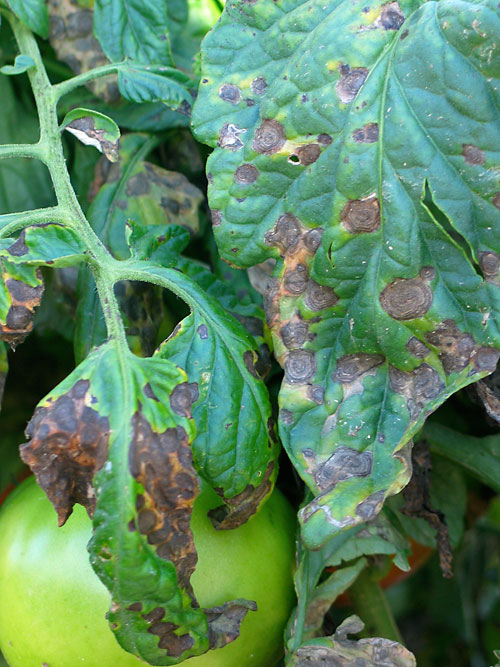
By Sarah Browning, Extension Educator
Nothing is better than a home-grown, garden tomato, but growing tomatoes does have its pitfalls, including disease problems. Tomatoes are subject to many diseases, both leaf spots and wilts.
Tomatoes are attacked by both fungi and bacterial diseases that affect the leaves, petioles and stems, and cause blemishes on the fruits. Foliage diseases weaken infected plants by killing the leaves, which are the plant’s factories for carbohydrate and energy production. Loss of foliage due to disease, causes the tomato plant to be less productive or vigorous. If foliage diseases are not controlled, they can lead to death of the plant.
If too many leaves are killed, then tomato production and quality will be affected. Severe foliage loss can lead to sunscald on developing tomatoes, which are suddenly exposed to more intense sunlight.
COMMON TOMATO DISEASES
Septoria leaf spot and early blight are two common fungal leaf diseases, while bacterial leaf spot and speck are caused by bacteria.
They all overwinter in the vegetable garden on infected plant debris. Fungal spores are spread during the growing season by wind, water and human activity. Bacterial infections are spread primarily through rain splash and human activity.
Septoria leaf spot begins as tiny black dots on the leaves, enlarging to small circular spots with a dark margin and gray center. Infected leaves turn yellow and die. Elongated lesions develop on stems and petioles.
Early blight appears as irregular, dark brown areas on the leaves with concentric, black rings developing into a target-like pattern as the spots enlarge. Dark brown, sunken lesions form on stems and petioles. These symptoms appear about 10 days after infection. Early blight occurs in midsummer during warm, humid periods and can spread very rapidly.
Bacterial speck and spot are both spread from infected plant debris during periods of humid, wet weather. Bacterial speck appears as tiny, pinhead sized, raised black specks on tomato leaves and fruits.
Bacterial spot is very similar to bacterial speck, but the leaf and fruit spots are slightly larger. On tomato fruits, bacterial spot results in slightly raised, brown, scabby lesions.
DISEASE CONTROL
Keep tomato leaves as dry as possible by applying water to the base of plants through soaker hoses, instead of using an overhead sprinkler. Water on the leaf surface promotes germination of fungal spores and leaf infection. There isn’t anything you can do about leaf wetness from rain or heavy dew, but you can avoid contributing to leaf wetness with your irrigation practices. Proper plant spacing allows leaves to dry after rain as quickly as possible.
If your vegetable garden is not mulched, then mulch it! One of the most common methods of tomato leaf infection is through rain splashing on bare soil. All of the diseases mentioned above overwinter on infected plant debris in the soil. During a rainstorm, water droplets hit the soil surface, splashing water and soil up onto the lowest tomato leaves.
Prevent rain splash in your garden by covering the soil with mulch. Apply a 2–3 inch layer of mulch, using clean straw, black plastic, newspapers topped with wood chips or any other coarse organic material. Mulch also helps suppresses weed growth, moderates soil temperature extremes and helps retain soil moisture.
Suppression of leaf spot diseases, once plants have been infected, can be accomplished through sanitation and the application of fungicides. Remove and discard heavily infected plants. Minor infections may be slowed by removing diseased leaves as they appear.
Fungicides are protective; they keep healthy leaves from becoming infected. Fungicides are not curative. This means that infected foliage will remain diseased and may die. Fungicides must be applied on a regular basis to provide continued protection for the healthy leaves.
Fungicides commonly used in vegetable gardens include:
• liquid copper (Bonide Copper Fungicide)
• chlorothalonil (GardenTech Daconil, Bonide Fung-onil)
• mancozeb (Bonide Mancozeb)
• myclobutanil (Spectracide Immunox)
• neem oil (Bonide Neem Oil, Garden Safe Fungicide 2)
• sulfur (Bonide Sulfur Plant Fungicide)
These products are readily available at most garden centers. Read the fungicide label carefully!
Make specific note of these points:
• Determine how to use the product without causing plant damage.
• How often the product should be applied to provide effective disease control.
• How many days you must wait after the fungicide is applied before produce can be harvested.
SANITATION
Sanitation is very important for reducing disease pressure in your garden each year. This fall, remove all plant debris that is left in the garden before tilling.
Establish a 3–4 year rotation schedule in your garden, by moving those plants most affected by disease to containers or new plots of ground. Or choose not to grow heavily affected plants for a few years to reduce populations of disease organisms in the soil.
*Reference to commercial products or trade names is made with the understanding that no discrimination is intended and no endorsement by the University of Nebraska–Lincoln is implied.